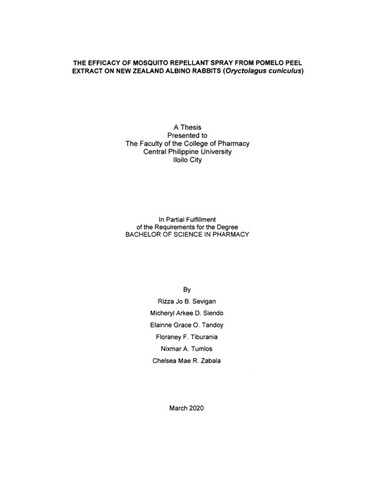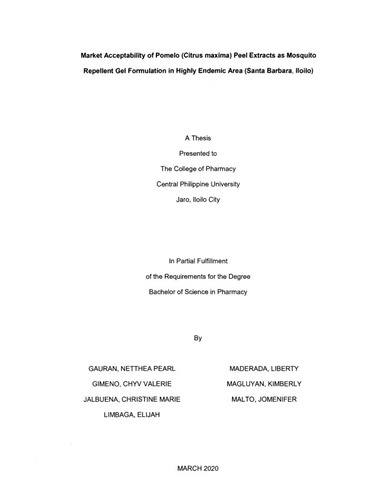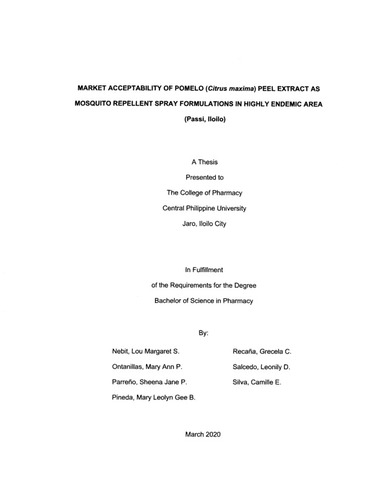Показать сокращенную информацию
Acute dermal toxicity of pomelo (Citrus maxima) essential oil extract as mosquito repellant on rabbits (Oryctolagus cuniculus)
| dc.contributor.adviser | Poral, Mylyn L. | |
| dc.contributor.author | Gallego, Carl Drake C. | |
| dc.contributor.author | Lerio, Nesje V. | |
| dc.contributor.author | Imperial, Mark Anthony I. | |
| dc.contributor.author | Margen, Lezyl Grace D. | |
| dc.contributor.author | Magno, Peter Dale D. | |
| dc.contributor.author | Hermogila, Micah J. | |
| dc.contributor.author | Herlandez, Mary Hope H. | |
| dc.contributor.author | Gonzales, Erika Marie J. | |
| dc.date.accessioned | 2022-01-05T05:49:06Z | |
| dc.date.available | 2022-01-05T05:49:06Z | |
| dc.date.issued | 2020 | |
| dc.identifier.citation | Gallego, C. D. C. , Lerio, N. V., Imperial, M. A. I. , Margen, L. G. D. , Magno, P. D. D. , Hermogila, M. J. , Herlandez, M. H. H. , & Gonzales, E. M. J. (2020). Acute dermal toxicity of pomelo (Citrus maxima) essential oil extract as mosquito repellant on rabbits (Oryctolagus cuniculus) (Unpublished thesis). Central Philippine University, Jaro, Iloilo City. | en_US |
| dc.identifier.uri | https://hdl.handle.net/20.500.12852/1849 | |
| dc.description | Abstract only | en_US |
| dc.description.abstract | This study was designed for the purpose of evaluating acute dermal toxicity of Pomelo (Citrus maxima) peel essential oil extract which is known for its possible mosquito repellency in human and animals. This followed the limited availability of information regarding dermal toxicity of this citrus plant in Western Visayas (Region VI) despite the growing practice of utilizing the fruit peel essential oil as mosquito repellant. The fruit peel was subjected to steam distillation extraction process using aqueous solvent. All test animals were obtained from a New Zealand white rabbit breeder. Thus, acute dermal toxicity tests were conducted in healthy rabbits using the Institutional Animal Care and Use Committee (IACUC) guidelines. Irritation indices a 00 result, thus according to Draize these are considered as no occurrence of erythema and edema since none of them could reach PII of 5. On the other hand, findings from acute dermal toxicity tests showed no any overt signs of toxicity after 72 hours of treatment. Findings from this study have shown that, extracts from the peel of C. maxima exhibit acute dermal toxicity effects. The findings therefore suggests that essential oil extracts from the peel of C. maxima under its use as mosquito repellant applied on skin of rabbits do not cause any adverse effects externally. | en_US |
| dc.format.extent | ix, 54 leaves | en_US |
| dc.language.iso | en | en_US |
| dc.subject.ddc | Filipiniana Theses 615.072 G135 | en_US |
| dc.subject.lcsh | Pummelo | en_US |
| dc.subject.lcsh | Toxicity testing | en_US |
| dc.subject.lcsh | Plant extracts | en_US |
| dc.subject.lcsh | Essences and essential oils | en_US |
| dc.subject.lcsh | Insect baits and repellents | en_US |
| dc.subject.lcsh | Repellents | en_US |
| dc.subject.lcsh | Mosquitoes--Biological control | en_US |
| dc.subject.lcsh | Rabbits | en_US |
| dc.subject.lcsh | Skin tests | en_US |
| dc.subject.lcsh | Repellents--Testing | en_US |
| dc.subject.lcsh | Insect baits and repellents--Testing | en_US |
| dc.title | Acute dermal toxicity of pomelo (Citrus maxima) essential oil extract as mosquito repellant on rabbits (Oryctolagus cuniculus) | en_US |
| dc.type | Thesis | en_US |
| dc.description.bibliographicalreferences | Includes bibliographical references | en_US |
| dc.contributor.chair | Marañon, Darlene Joy J. | |
| dc.contributor.committeemember | Pedroso, Pearl Angeli P. | |
| dc.contributor.committeemember | Penetrante, Mary O' T. | |
| dc.contributor.department | College of Pharmacy | en_US |
| dc.description.degree | Bachelor of Science in Pharmacy | en_US |
| local.subject | Pomelo | en_US |
| local.subject.scientificname | Citrus maxima | en_US |
| local.subject.scientificname | Oryctolagus cuniculus | en_US |





